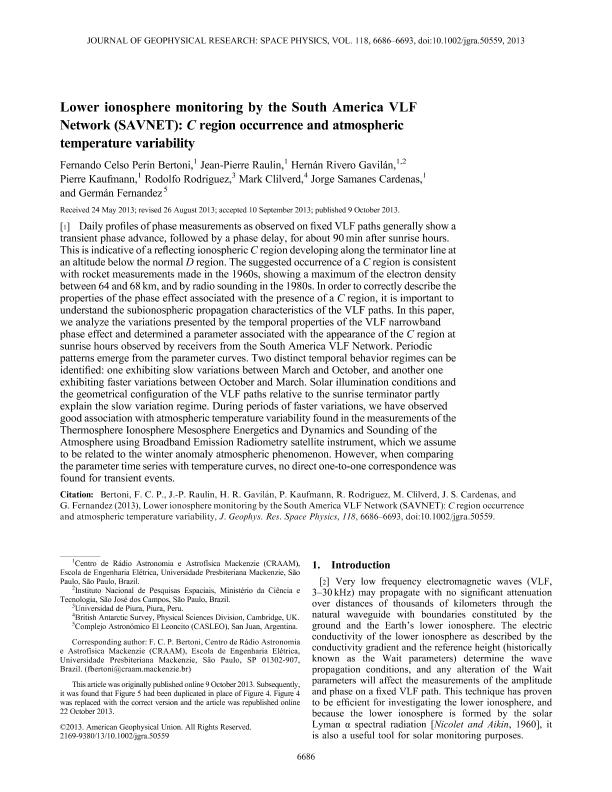Mostrar el registro sencillo del ítem
dc.contributor.author
Perin Bertoni, Fernando Celso
dc.contributor.author
Raulin, Jean Pierre
dc.contributor.author
Rivero Gavilán, Hernán
dc.contributor.author
Kaufmann, Pierre
dc.contributor.author
Rodriguez, Rodolfo
dc.contributor.author
Clilverd, Mark
dc.contributor.author
Samanes Cárdenas, Jorge
dc.contributor.author
Fernandez, German Enzo Leonel

dc.date.available
2016-12-06T19:43:31Z
dc.date.issued
2013-10
dc.identifier.citation
Perin Bertoni, Fernando Celso; Raulin, Jean Pierre; Rivero Gavilán, Hernán; Kaufmann, Pierre; Rodriguez, Rodolfo; et al.; Lower ionosphere monitoring by the South America VLF Network (SAVNET): C region occurrence and atmospheric temperature variability; American Geophysical Union; Journal Of Geophysical Research; 118; 10; 10-2013; 6686-6693
dc.identifier.issn
0148-0227
dc.identifier.uri
http://hdl.handle.net/11336/8922
dc.description.abstract
Daily profiles of phase measurements as observed on fixed VLF paths generally show a transient phase advance, followed by a phase delay, for about 90 min after sunrise hours. This is indicative of a reflecting ionospheric C region developing along the terminator line at an altitude below the normal D region. The suggested occurrence of a C region is consistent with rocket measurements made in the 1960s, showing a maximum of the electron density between 64 and 68 km, and by radio sounding in the 1980s. In order to correctly describe the properties of the phase effect associated with the presence of a C region, it is important to understand the subionospheric propagation characteristics of the VLF paths. In this paper, we analyze the variations presented by the temporal properties of the VLF narrowband phase effect and determined a parameter associated with the appearance of the C region at sunrise hours observed by receivers from the South America VLF Network. Periodic patterns emerge from the parameter curves. Two distinct temporal behavior regimes can be identified: one exhibiting slow variations between March and October, and another one exhibiting faster variations between October and March. Solar illumination conditions and the geometrical configuration of the VLF paths relative to the sunrise terminator partly explain the slow variation regime. During periods of faster variations, we have observed good association with atmospheric temperature variability found in the measurements of the Thermosphere Ionosphere Mesosphere Energetics and Dynamics and Sounding of the Atmosphere using Broadband Emission Radiometry satellite instrument, which we assume to be related to the winter anomaly atmospheric phenomenon. However, when comparing the parameter time series with temperature curves, no direct one-to-one correspondence was found for transient events.
dc.format
application/pdf
dc.language.iso
eng
dc.publisher
American Geophysical Union

dc.rights
info:eu-repo/semantics/openAccess
dc.rights.uri
https://creativecommons.org/licenses/by-nc-sa/2.5/ar/
dc.subject
Ionosphere
dc.subject
Vlf Technique
dc.subject
Solar Monitoring
dc.subject
Upper And Lower Atmosphere Interaction
dc.subject.classification
Meteorología y Ciencias Atmosféricas

dc.subject.classification
Ciencias de la Tierra y relacionadas con el Medio Ambiente

dc.subject.classification
CIENCIAS NATURALES Y EXACTAS

dc.subject.classification
Ingeniería Eléctrica y Electrónica

dc.subject.classification
Ingeniería Eléctrica, Ingeniería Electrónica e Ingeniería de la Información

dc.subject.classification
INGENIERÍAS Y TECNOLOGÍAS

dc.title
Lower ionosphere monitoring by the South America VLF Network (SAVNET): C region occurrence and atmospheric temperature variability
dc.type
info:eu-repo/semantics/article
dc.type
info:ar-repo/semantics/artículo
dc.type
info:eu-repo/semantics/publishedVersion
dc.date.updated
2016-12-06T16:33:11Z
dc.journal.volume
118
dc.journal.number
10
dc.journal.pagination
6686-6693
dc.journal.pais
Estados Unidos

dc.journal.ciudad
Hoboken
dc.description.fil
Fil: Perin Bertoni, Fernando Celso. Universidade Presbiteriana Mackenzie. Escola de Engenharia. Centro de Radio Astronomia E Astrofisica; Brasil
dc.description.fil
Fil: Raulin, Jean Pierre. Universidade Presbiteriana Mackenzie. Escola de Engenharia. Centro de Radio Astronomia E Astrofisica; Brasil
dc.description.fil
Fil: Rivero Gavilán, Hernán. Universidade Presbiteriana Mackenzie. Escola de Engenharia. Centro de Radio Astronomia E Astrofisica; Brasil. Ministério da Ciência e Tecnologia. Instituto Nacional de Pesquisas Espaciais; Brasil
dc.description.fil
Fil: Kaufmann, Pierre. Universidade Presbiteriana Mackenzie. Escola de Engenharia. Centro de Radio Astronomia E Astrofisica; Brasil
dc.description.fil
Fil: Rodriguez, Rodolfo. Universidad de Piura; Perú
dc.description.fil
Fil: Clilverd, Mark. University Of Cambridge; Reino Unido
dc.description.fil
Fil: Samanes Cárdenas, Jorge. Universidade Presbiteriana Mackenzie. Escola de Engenharia. Centro de Radio Astronomia E Astrofisica; Brasil
dc.description.fil
Fil: Fernandez, German Enzo Leonel. Consejo Nacional de Investigaciones Cientíâficas y Técnicas. Centro Cientíâfico Tecnológico San Juan. Complejo Astronómico "el Leoncito"; Argentina
dc.journal.title
Journal Of Geophysical Research

dc.relation.alternativeid
info:eu-repo/semantics/altIdentifier/url/http://onlinelibrary.wiley.com/doi/10.1002/jgra.50559/full
dc.relation.alternativeid
info:eu-repo/semantics/altIdentifier/doi/http://dx.doi.org/10.1002/jgra.50559
Archivos asociados
